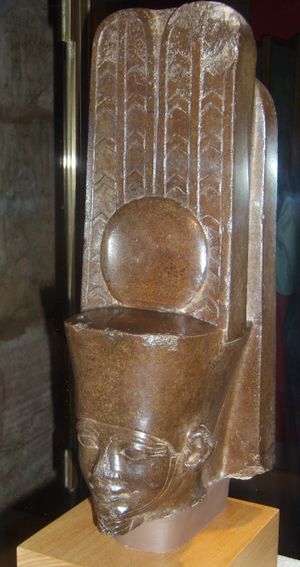تنتاماني
| تنتاماني | |||||
|---|---|---|---|---|---|
| Kushite King of Napata | |||||
 Head of a statue, perhaps showing Amun, bearing the name of Tantamani on its back pillar (Ashmolean Museum) | |||||
| المدفن | El-Kurru (K. 16) | ||||
| الزوج | Piankharty, [..]salka, possibly Malaqaye, | ||||
| الأنجال | Possibly Atlanersa, Queen Yeturow, Queen Khaliset | ||||
| |||||
| الأب | Shabaka (or Shebitku?) | ||||
| الأم | Queen Qalhata | ||||
تنتاماني Tantamani (بالآشورية: UR-daname)؛ Tanutamun أو Tanwetamani (بالمصرية) أو Tementhes (ياليونانية) (ت. 653 ق.م.) كان فرعون مصر ومملكة كوش الواقعة في شمال السودان and a member of the Nubian or Twenty-fifth dynasty of Egypt. His prenomen or royal name was Bakare which means "Glorious is the Soul of Re."[1]
He was the son of King Shabaka and the nephew of his predecessor Taharqa.[2] In some sources he is said to be the son of Shebitku.[3] Assyrian records call Tantamani a son of Shabaka and refer to Qalhata as a sister of Taharqa. Some Egyptologists interpreted the Assyrian text as stating that Tantamani was a son of Shebitku, but as he was most likely a son of Shabaka himself, it is now more common to consider Tantamani a son of Shabaka.[4]
Once the Assyrians had appointed Necho I as king and left Egypt, Tantamani marched down the Nile from Nubia and reoccupied all of Egypt including Memphis. Necho I, the Assyrians' representative, was killed in Tantamani's campaign. In reaction, the Assyrians returned to Egypt in force, defeated Tantamani's army in the Delta and advanced as far south as Thebes, which they sacked. The Assyrian reconquest effectively ended Nubian control over Egypt although Tantamani's authority was still recognised in Upper Egypt until his 8th Year in 656 BC when Psamtik I's navy peacefully took control of Thebes and effectively unified all of Egypt.
وبعد ذلك، حكم تنتاماني النوبة فقط (كوش). Tantamani died in 653 BC and was succeeded by Atlanersa, a son of Taharqa. He was buried in the family cemetery at El-Kurru. The archaeologist Charles Bonnet discovered the statue of Tantamani at Kerma (now called Doukki Gel) in 2003.[5]
. . . . . . . . . . . . . . . . . . . . . . . . . . . . . . . . . . . . . . . . . . . . . . . . . . . . . . . . . . . . . . . . . . . . . . . . . . . . . . . . . . . . . . . . . . . . . . . . . . . . . . . . . . . . . . . . . . . . . . . . . . . . . . . . . . . . . . . . . . . . . . . . . . . . . . . . . . . . . . . . . . . . . . . .
المراجع
- ^ Peter A. Clayton, Chronicle of the Pharaohs: The Reign-by-Reign Record of the Rulers and Dynasties of Ancient Egypt, Thames and Hudson, London, 1994. p.190
- ^ Aidan Dodson & Dyan Hilton: The Complete Royal Families of Ancient Egypt. Thames & Hudson, 2004, ISBN 0-500-05128-3
- ^ Dows Dunham, M. F. Laming Macadam: Names and Relationships of the Royal Family of Napata, Journal of Egyptian Archaeology. 35, 1949, pp.139-149
- ^ R.G. Morkot, The Black Pharaohs: Egypt's Nubian Rulers, 2000, The Rubicon Press
- ^ Digging into Africa's past
للاستزادة
- Robert Morkot, The Black Pharaohs: Egypt's Nubian Rulers, The Rubicon Press, 2000. ISBN 0-948695-23-4
| ألقاب ملكية | ||
|---|---|---|
| سبقه طهارقا |
فرعون مصر 664 – 656 ق.م. الأسرة الخامسة والعشرون |
تبعه پسامتيك الأول |
| ملك كوش 664 – 653 ق.م. |
تبعه Atlanersa | |
